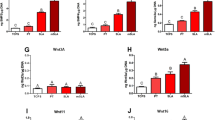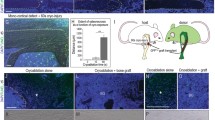Abstract
Wnt signaling maintains homeostasis in the bone marrow cavity: if Wnt signaling is inhibited then bone volume and density would decline. In this study, we identified a population of Wnt-responsive cells as osteoprogenitor in the intact trabecular bone region, which were responsible for bone development and turnover. If an implant was placed into the long bone, this Wnt-responsive population and their progeny contributed to osseointegration. We employed Axin2CreCreERT2/+;R26mTmG/+ transgenic mouse strain in which Axin2-positive, Wnt-responsive cells, and their progeny are permanently labeled by GFP upon exposure to tamoxifen. Each mouse received femoral implants placed into a site prepared solely by drilling, and a single-dose liposomal WNT3A protein was used in the treatment group. A lineage tracing strategy design allowed us to identify cells actively expressing Axin2 in response to Wnt signaling pathway. These tools demonstrated that Wnt-responsive cells and their progeny comprise a quiescent population residing in the trabecular region. In response to an implant placed, this population becomes mitotically active: cells migrated into the peri-implant region, up-regulated the expression of osteogenic proteins. Ultimately, those cells gave rise to osteoblasts that produced significantly more new bone in the peri-implant region. Wnt-responsive cells directly contributed to implant osseointegration. Using a liposomal WNT3A protein therapeutic, we showed that a single application at the time of implant placed was sufficient to accelerate osseointegration. The Wnt-responsive cell population in trabecular bone, activated by injury, ultimately contributes to implant osseointegration. Liposomal WNT3A protein therapeutic accelerates implant osseointegration in the long bone.




Similar content being viewed by others
References
Davila Castrodad IM et al (2019) Rehabilitation protocols following total knee arthroplasty: a review of study designs and outcome measures. Ann Transl Med 7(Suppl 7):S255
Branemark PI (1983) Osseointegration and its experimental background. J Prosthet Dent 50(3):399–410
Adell R et al (1981) A 15-year study of osseointegrated implants in the treatment of the edentulous jaw. Int J Oral Surg 10(6):387–416
Heinecke M et al (2018) The proximal and distal femoral canal geometry influences cementless stem anchorage and revision hip and knee implant stability. Orthopedics 41(3):e369–e375
Pilliar RM, Lee JM, Maniatopoulos C (1986) Observations on the effect of movement on bone ingrowth into porous-surfaced implants. Clin Orthop Relat Res 208:108–113
Malak TT et al (2016) Surrogate markers of long-term outcome in primary total hip arthroplasty: a systematic review. Bone Jt Res 5(6):206–214
Ramamurti BS et al (1997) Factors influencing stability at the interface between a porous surface and cancellous bone: a finite element analysis of a canine in vivo micromotion experiment. J Biomed Mater Res 36(2):274–280
Liu Y et al (2019) WNT3A accelerates delayed alveolar bone repair in ovariectomized mice. Osteoporos Int 30:1873–1885
Rodari G et al (2018) Progressive bone impairment with age and pubertal development in neurofibromatosis type I. Arch Osteoporos 13(1):93
Alghamdi HS, van den Beucken JJ, Jansen JA (2014) Osteoporotic rat models for evaluation of osseointegration of bone implants. Tissue Eng C 20(6):493–505
He YX et al (2011) Impaired bone healing pattern in mice with ovariectomy-induced osteoporosis: a drill-hole defect model. Bone 48(6):1388–1400
Song L et al (2012) Loss of wnt/beta-catenin signaling causes cell fate shift of preosteoblasts from osteoblasts to adipocytes. J Bone Miner Res 27(11):2344–2358
Zhang X et al (2018) Global transcriptome analysis to identify critical genes involved in the pathology of osteoarthritis. Bone Jt Res 7(4):298–307
Boyden LM et al (2002) High bone density due to a mutation in LDL-receptor-related protein 5. N Engl J Med 346(20):1513–1521
Lewiecki EM et al (2019) One year of romosozumab followed by two years of denosumab maintains fracture risk reductions: results of the FRAME Extension Study. J Bone Miner Res 34(3):419–428
Sovak G, Weiss A, Gotman I (2000) Osseointegration of Ti6Al4V alloy implants coated with titanium nitride by a new method. J Bone Jt Surg Br 82(2):290–296
Workman P et al (2010) Guidelines for the welfare and use of animals in cancer research. Br J Cancer 102(11):1555–1577
Szot GL, Koudria P, Bluestone JA (2007) Transplantation of pancreatic islets into the kidney capsule of diabetic mice. J Vis Exp. https://doi.org/10.3791/404
Movat HZ (1955) Demonstration of all connective tissue elements in a single section; pentachrome stains. AMA Arch Pathol 60(3):289–295
Leucht P et al (2007) Accelerated bone repair after plasma laser corticotomies. Ann Surg 246(1):140–150
Minear S et al (2010) Wnt proteins promote bone regeneration. Sci Transl Med 2(29):29ra30
Kawamoto T, Kawamoto K (2014) Preparation of thin frozen sections from nonfixed and undecalcified hard tissues using Kawamot’s film method (2012). Methods Mol Biol 1130:149–164
Yuan X et al (2018) Biomechanics of immediate postextraction implant osseointegration. J Dent Res 97(9):987–994
Sun Q et al (2019) Improving intraoperative storage conditions for autologous bone grafts: an experimental investigation in mice. J Tissue Eng Regen Med 13(12):2169–2180
Jing W et al (2015) Reengineering autologous bone grafts with the stem cell activator WNT3A. Biomaterials 47:29–40
Popelut A et al (2010) The acceleration of implant osseointegration by liposomal Wnt3a. Biomaterials 31(35):9173–9181
Dhamdhere GR et al (2014) Drugging a stem cell compartment using Wnt3a protein as a therapeutic. PLoS ONE 9(1):e83650
Morrell NT et al (2008) Liposomal packaging generates Wnt protein with in vivo biological activity. PLoS ONE 3(8):e2930
Hoyte DAN (1966) Experimental investigations of skull morphology and growth W.J.L. Felts and R.J. Harrison (eds). Int Rev Gen Exp Zool 2:345–407
Labek G et al (2011) Revision rates after total joint replacement: cumulative results from worldwide joint register datasets. J Bone Jt Surg Br 93(3):293–297
Sadoghi P et al (2013) Revision surgery after total joint arthroplasty: a complication-based analysis using worldwide arthroplasty registers. J Arthroplast 28(8):1329–1332
Apostu D et al (2018) Current methods of preventing aseptic loosening and improving osseointegration of titanium implants in cementless total hip arthroplasty: a review. J Int Med Res 46(6):2104–2119
Lam YF et al (2016) A review of the clinical approach to persistent pain following total hip replacement. Hong Kong Med J 22(6):600–607
Piscitelli P et al (2013) Painful prosthesis: approaching the patient with persistent pain following total hip and knee arthroplasty. Clin Cases Miner Bone Metab 10(2):97–110
Abu-Amer Y, Darwech I, Clohisy JC (2007) Aseptic loosening of total joint replacements: mechanisms underlying osteolysis and potential therapies. Arthritis Res Ther 9(Suppl 1):S6
Janssen D et al (2010) Computational assessment of press-fit acetabular implant fixation: the effect of implant design, interference fit, bone quality, and frictional properties. Proc Inst Mech Eng H 224(1):67–75
Soballe K et al (1992) Tissue ingrowth into titanium and hydroxyapatite-coated implants during stable and unstable mechanical conditions. J Orthop Res 10(2):285–299
Nazemi SM et al (2017) Optimizing finite element predictions of local subchondral bone structural stiffness using neural network-derived density–modulus relationships for proximal tibial subchondral cortical and trabecular bone. Clin Biomech (Bristol Avon) 41:1–8
Goltzman D (2019) The aging skeleton. Adv Exp Med Biol 1164:153–160
Salmon B et al (2017) WNT-activated bone grafts repair osteonecrotic lesions in aged animals. Sci Rep 7(1):14254
Virdi AS et al (2015) Sclerostin antibody treatment improves implant fixation in a model of severe osteoporosis. J Bone Jt Surg Am 97(2):133–140
Pei X et al (2017) Contribution of the PDL to osteotomy repair and implant osseointegration. J Dent Res 96(8):909–916
Li Z et al (2020) Effects of condensation and compressive strain on implant primary stability: a longitudinal, in vivo, multiscale study in mice. Bone Jt Res 9(2):60–70
Acknowledgements
We thank Dr. Yindong Liu, Bo Liu, and Dr. Giuseppe Salvi for their contributions to this manuscript. This work was supported by a Grant from the NIH (R01 DE024000-12) to JAH.
Author information
Authors and Affiliations
Corresponding author
Additional information
Publisher's Note
Springer Nature remains neutral with regard to jurisdictional claims in published maps and institutional affiliations.
Electronic supplementary material
Rights and permissions
About this article
Cite this article
Li, Z., Yuan, X., Arioka, M. et al. Pro-osteogenic Effects of WNT in a Mouse Model of Bone Formation Around Femoral Implants. Calcif Tissue Int 108, 240–251 (2021). https://doi.org/10.1007/s00223-020-00757-5
Received:
Accepted:
Published:
Issue Date:
DOI: https://doi.org/10.1007/s00223-020-00757-5





